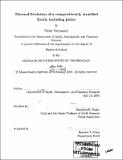Thermal evolution of a compositionally stratified earth, including plates
Author(s)
Vermeesch, Pieter, 1976-
DownloadFull printable version (3.305Mb)
Other Contributors
Massachusetts Institute of Technology. Dept. of Earth, Atmospheric, and Planetary Sciences.
Advisor
Bradford H. Hager.
Terms of use
Metadata
Show full item recordAbstract
For subduction to occur, plates must bend and slide past overriding plates along fault zones. This deformation is associated with significant energy dissipation, which changes the energy balance of mantle convection and influences the thermal history of the Earth. To parameterize these effects, a subduction zone was included in a small region of a finite element model for the mantle, which also features an asthenosphere and a mid-oceanic ridge. Velocity boundary conditions were imposed in the vicinity of the subduction. We present theoretical arguments for, and numerical illustrations of the fact that for most modes of deformation, the simple powerlaw relationship of parameterized convection Nu ~ Ra[beta] is not valid anymore, although it is still a good first order approximation. In the case of viscous bending dissipation and non-depth dependent brittle simple shear however, Nu ~ Ra[beta] does hold. [Beta] is less than the value of 1/3 predicted by standard boundary layer theory. For viscous energy dissipation, two different regimes of mantle convection can be considered, depending on the effective viscosity of the lithosphere: the "mobile lid" regime, and the "stagnant lid" regime. For brittle dissipation, the lithosphere strength is a function of yield stress which, when nearing a certain critical value, introduces a third regime, that of the "episodic overturning". Within the "mobile lid" regime, the plate velocities for models with a subduction zone governed by brittle behavior are far less dependent on the plate stress than those models with viscous deformation. This suggests that the plate motion is resisted by viscous stresses in the mantle. The "mobile lid" would be representative for mantle convection associated with plate tectonics, as we observe on Earth. A "stagnant lid" would be the case for the Moon or Mars, while Venus could experience the "episodic overturn" regime featuring cyclic and catastrophic brittle mobilization of a lithosphere with high friction coefficient.
Description
Thesis (S.M.)--Massachusetts Institute of Technology, Dept. of Earth, Atmospheric, and Planetary Sciences, 2000. Includes bibliographical references (p. 61-62).
Date issued
2000Department
Massachusetts Institute of Technology. Department of Earth, Atmospheric, and Planetary SciencesPublisher
Massachusetts Institute of Technology
Keywords
Earth, Atmospheric, and Planetary Sciences.